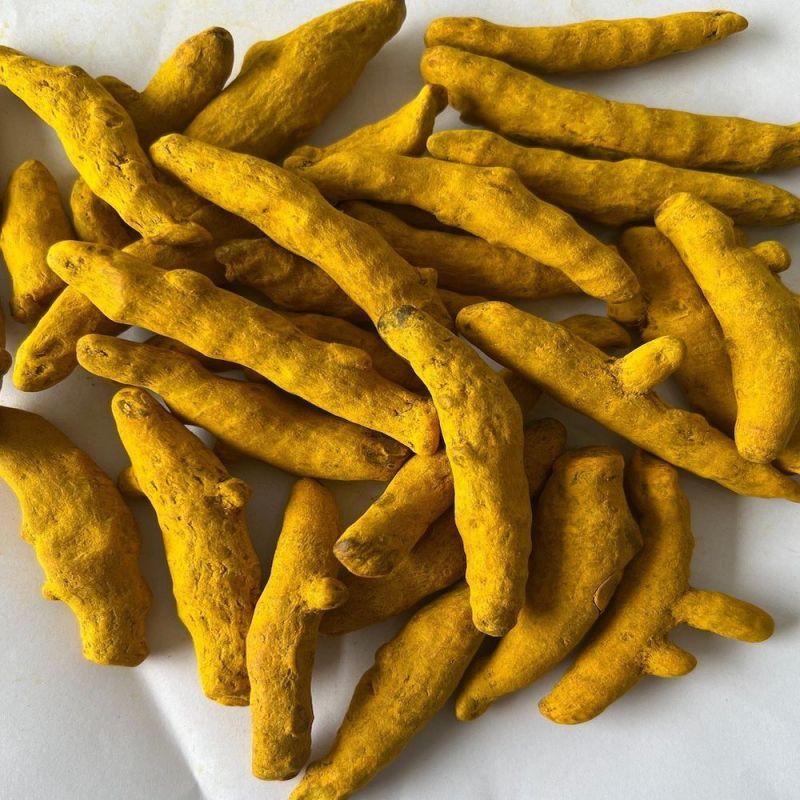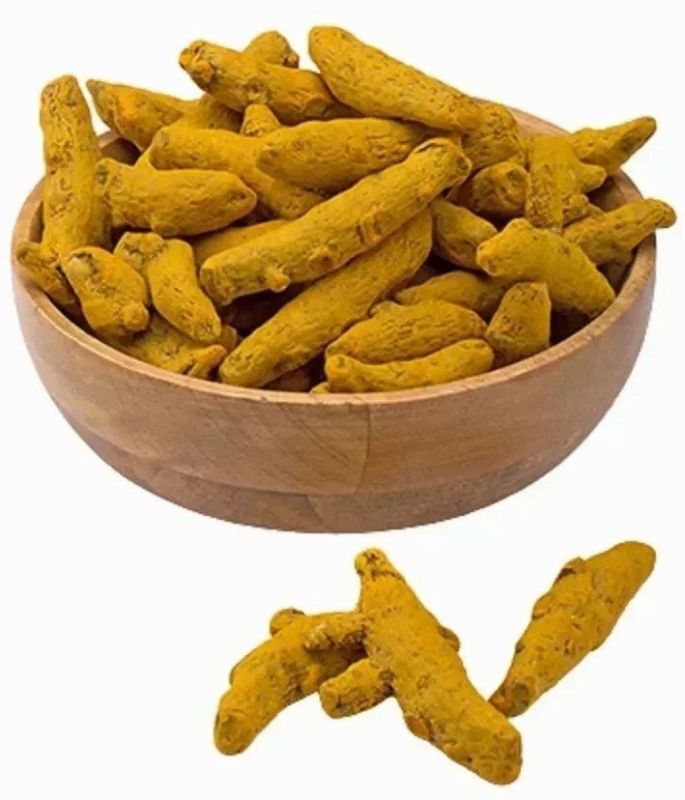nitin@vertexusglobal.com - GST NO. : 19ABAFV5939N1ZD
- Send Email
Turmeric Finger
Leading Exporters, Wholesaler and Trader of Alleppey Turmeric Finger, Erode Turmeric Finger, Lakadong Turmeric Finger, Nizam Turmeric Finger, Salem Turmeric Finger and Sangli Turmeric Finger from Kolkata.
| Business Type | Exporter, Supplier, Trader |
| Cultivation Type | Organic |
| Quality Available | Alleppey |
| Color | Yellow |
| Grade Standard | Food Grade |
| Usage/Application | Cooking |
| Style | Raw |
| Shelf Life | 1 Year |
| Storage Instructions | Dry Place |
| Country of Origin | India |
Turmeric (Curcuma longa) belongs to the Zingiberaceae family. The commercial part of the plant is its rhizome. It grows in light black, black clayey loams and red soils in irrigated and rainfed conditions with temperature ranging between 20 to 30 degrees. The crop cannot stand water-logging or alkalinity. Turmeric is used to flavour and to colour foodstuffs. It is used in cosmetics and in medicines. Turmeric is ready for harvesting in 7-9 months. Sowing starts from May end with the onset of monsoon and extends till August while arrivals start from December – January and extend up to May across various producing centers.
India currently meets an annual production demand of about 8 lakh MT of cured turmeric. It is the largest producer of turmeric in the world and contributes to almost 80% of the total production. About 92% of the produce is consumed domestically and the remaining 8% is exported.
Alleppey Turmeric is a rare turmeric grown in Kerala. It typically has a curcumin content ranging from 5% to 6.5%, which is higher than most other turmeric varieties grown in India. Curcumin is the active compound responsible for many of turmeric's health benefits. When ground, Alleppey fingers produce a deep, golden-yellow color powder with a strong, earthy flavor having subtle notes of lemon and mint, making it a flavorful and healthy addition to dishes. Colour of Rhizomes is reddish orange.
| Business Type | Exporter, Supplier, Trader |
| Cultivation Type | Organic |
| Quality Available | Erode |
| Color | Yellow |
| Grade Standard | Food Grade |
| Usage/Application | Cooking |
| Style | Raw |
| Shelf Life | 1 Year |
| Storage Instructions | Dry Place |
| Country of Origin | India |
Turmeric (Curcuma longa) belongs to the Zingiberaceae family. The commercial part of the plant is its rhizome. It grows in light black, black clayey loams and red soils in irrigated and rainfed conditions with temperature ranging between 20 to 30 degrees. The crop cannot stand water-logging or alkalinity. Turmeric is used to flavour and to colour foodstuffs. It is used in cosmetics and in medicines. Turmeric is ready for harvesting in 7-9 months. Sowing starts from May end with the onset of monsoon and extends till August while arrivals start from December – January and extend up to May across various producing centers.
India currently meets an annual production demand of about 8 lakh MT of cured turmeric. It is the largest producer of turmeric in the world and contributes to almost 80% of the total production. About 92% of the produce is consumed domestically and the remaining 8% is exported.
- It is one of the popular cultivars of Tamil Nadu with good market acceptability.
- Plants are vigorous and tall with good yield potential (30-32 t/ha).
- Fingers are short, slightly bent with a deep orange inner core, with a moderate curing percentage.
- curcumin content is 3.9 per cent.
| Business Type | Exporter, Supplier, Trader |
| Cultivation Type | Organic |
| Quality Available | Lakadong |
| Color | Yellow |
| Grade Standard | Food Grade |
| Usage/Application | Cooking |
| Style | Raw |
| Shelf Life | 1 Year |
| Storage Instructions | Dry Place |
| Country of Origin | India |
Turmeric (Curcuma longa) belongs to the Zingiberaceae family. The commercial part of the plant is its rhizome. It grows in light black, black clayey loams and red soils in irrigated and rainfed conditions with temperature ranging between 20 to 30 degrees. The crop cannot stand water-logging or alkalinity. Turmeric is used to flavour and to colour foodstuffs. It is used in cosmetics and in medicines. Turmeric is ready for harvesting in 7-9 months. Sowing starts from May end with the onset of monsoon and extends till August while arrivals start from December – January and extend up to May across various producing centers.
India currently meets an annual production demand of about 8 lakh MT of cured turmeric. It is the largest producer of turmeric in the world and contributes to almost 80% of the total production. About 92% of the produce is consumed domestically and the remaining 8% is exported.
Lakadong turmeric is a high-quality, organic turmeric variety from the Jaintia Hills of Meghalaya, India, renowned for its exceptionally high curcumin content, which can range from 7% to over 11%. This potent curcumin makes it a powerful anti-inflammatory and antioxidant with significant health benefits, far exceeding the 1-3% found in regular turmeric. Cultivated using traditional methods with no chemical pesticides, it's known for its vibrant color, distinct flavor, and wide use in the cosmetic, Pharmaceutical & food inductries. Colour of the turmeric powder is fluorescent deep orange to bright yellow color, indicating high purity and curcumin content.
The most glaring difference when it comes to Lakadong is the level of curcumin – the active constituent within turmeric that is responsible for its therapeutic properties. With an average content of 7.5%, Lakadong far exceeds the 3% normally seen with other varieties.
Lakadong turmeric is recognised for the vibrant yellow colour that comes from the high curcumin content. This unique colour makes your food look appealing to the eye and more appetizing, especially if you’re a foodie! Other turmeric types, by comparison, give the food a not so appealing, even dull, appearance.
As you add your Lakadong turmeric to your curries the room is immediately filled with beautiful scents of earthy, delectable treats. Your curries’ aroma wafts through the air and right into the mouths and noses of those present. And it makes them feel good; a sense of satisfaction they received goes above and beyond what other turmeric powders could ever provide.
| Business Type | Exporter, Supplier, Trader |
| Cultivation Type | Organic |
| Quality Available | Nizam |
| Color | Yellow |
| Grade Standard | Food Grade |
| Usage/Application | Cooking |
| Style | Raw |
| Shelf Life | 1 Year |
| Storage Instructions | Dry Place |
| Country of Origin | India |
Turmeric (Curcuma longa) belongs to the Zingiberaceae family. The commercial part of the plant is its rhizome. It grows in light black, black clayey loams and red soils in irrigated and rainfed conditions with temperature ranging between 20 to 30 degrees. The crop cannot stand water-logging or alkalinity. Turmeric is used to flavour and to colour foodstuffs. It is used in cosmetics and in medicines. Turmeric is ready for harvesting in 7-9 months. Sowing starts from May end with the onset of monsoon and extends till August while arrivals start from December – January and extend up to May across various producing centers.
India currently meets an annual production demand of about 8 lakh MT of cured turmeric. It is the largest producer of turmeric in the world and contributes to almost 80% of the total production. About 92% of the produce is consumed domestically and the remaining 8% is exported.
Turmeric Finger (Nizam FAQ Grade) refers to a specific quality grade of turmeric roots sourced from the Nizamabad region in Telangana, India. Known for its moderate curcumin content, consistent color, and bold size, the Nizam FAQ (Fair Average Quality) Grade turmeric is a preferred choice for both domestic consumption and export markets.
“Fair Average Quality“, which ensures a good balance of cleanliness, size uniformity, aroma, and curcumin percentage. This grade is typically used in bulk processing, grinding into turmeric powder, and in industrial applications such as food coloring, herbal formulations, and cosmetics.
The Nizamabad region is celebrated for its rich soil and optimal climate, which contribute to turmeric with a natural bright yellow to golden-orange hue and a distinct earthy aroma. Although it may not have the highest curcumin levels compared to Alleppey or Salem turmeric, the Nizam FAQ Grade is valued for its affordability, availability, and stable quality.
| Business Type | Exporter, Supplier, Trader |
| Cultivation Type | Organic |
| Quality Available | Salem |
| Color | Yellow |
| Grade Standard | Food Grade |
| Usage/Application | Cooking |
| Style | Raw |
| Shelf Life | 1 Year |
| Storage Instructions | Dry Place |
| Country of Origin | India |
Turmeric (Curcuma longa) belongs to the Zingiberaceae family. The commercial part of the plant is its rhizome. It grows in light black, black clayey loams and red soils in irrigated and rainfed conditions with temperature ranging between 20 to 30 degrees. The crop cannot stand water-logging or alkalinity. Turmeric is used to flavour and to colour foodstuffs. It is used in cosmetics and in medicines. Turmeric is ready for harvesting in 7-9 months. Sowing starts from May end with the onset of monsoon and extends till August while arrivals start from December – January and extend up to May across various producing centers.
India currently meets an annual production demand of about 8 lakh MT of cured turmeric. It is the largest producer of turmeric in the world and contributes to almost 80% of the total production. About 92% of the produce is consumed domestically and the remaining 8% is exported.
- It is another popular cultivar of Tamil Nadu.
- The plants are vigorous and tall.
- Rhizomes are bigger and the fingers are longer than in Erode local (4 cm)
- Its yield potential is comparable with Erode local but rich in curcumin content (4.75 per cent) and moderate in curing percentage.
| Business Type | Exporter, Supplier, Trader |
| Cultivation Type | Organic |
| Quality Available | Sangli |
| Color | Yellow |
| Grade Standard | Food Grade |
| Usage/Application | Cooking |
| Style | Raw |
| Shelf Life | 1 Year |
| Storage Instructions | Dry Place |
| Country of Origin | India |
Turmeric (Curcuma longa) belongs to the Zingiberaceae family. The commercial part of the plant is its rhizome. It grows in light black, black clayey loams and red soils in irrigated and rainfed conditions with temperature ranging between 20 to 30 degrees. The crop cannot stand water-logging or alkalinity. Turmeric is used to flavour and to colour foodstuffs. It is used in cosmetics and in medicines. Turmeric is ready for harvesting in 7-9 months. Sowing starts from May end with the onset of monsoon and extends till August while arrivals start from December – January and extend up to May across various producing centers.
India currently meets an annual production demand of about 8 lakh MT of cured turmeric. It is the largest producer of turmeric in the world and contributes to almost 80% of the total production. About 92% of the produce is consumed domestically and the remaining 8% is exported.
Sangli is known as the Turmeric City of Maharashtra due to its production and trade of the spice. Sangli is situated on the banks of the river Krishna and is considered to be the largest and most important trading center for turmeric in Asia. Sangli has been cultivating its world-famous turmeric since the 1900s. The turmeric produced in Sangli is known for its high quality and is used in a variety of dishes and products.






